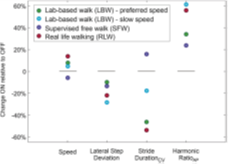Effective treatments are still rare in degenerative ataxias, the identification of the underlying gene defect in an increasing number of ataxias allows for targeted treatment developments and evaluations as part of a “precision medicine for ataxia”. In particular, the recently identified SCA27B, caused by GAA-repeat expansions in FGF14 , might not only represent one of the most common genetic causes of ataxia , but also respond at least partially to 4-aminopyridine (4-AP).
However, objective quantitative evidence for the efficacy of 4-AP in SCA27B is still starkly absent, inter alia due to the scarcity of pertinent outcome measures. For evaluating the treatment effects in both clinical trials and individual patient treatment settings, sensitive outcome measures have to be identified that show a change meaningful to patients. Gait assessment and in particular analysis of real-life walking behavior—which is ecologically more meaningful than in-clinic or lab assessments—can provide meaningful outcome measures for evaluating treatment interventions, as cerebellar ataxia patients report gait and functional mobility impairments as having the greatest impact on their daily lives.
Here, we present the first prospective single-subject gait sensor data in different walking conditions (including patient’s everyday life) with vs without 4-AP, demonstrating that (i) 4-AP improves ataxia-related gait characteristics in SCA27B, and that (ii) gait parameters assessable by body-worn sensors allow to capture the 4-AP on-/off effects also in—ecologically highly relevant—real-life conditions, even on a single subject level.
These results suggest that gait measures of step variability (in particular lateral step deviation) and gait regularity may serve as promising sensitive and meaningful and ecologically valid outcome measures, resulting in significantly smaller sample size compared to the SARA score as primary outcome. This is of immediate interest for the design of ataxia treatment trials.

Figure 1 Changes in ON relative to OFF for representative gait measures in ataxia-related gait domains for different walking conditions. Changes are computed by comparison of ON and OFF gait assessments which took place just 3 weeks apart in April 2023.
The full paper can be found here.





